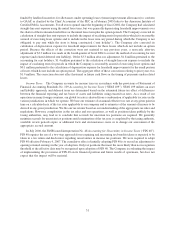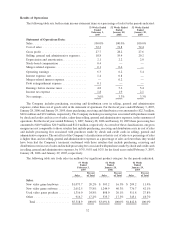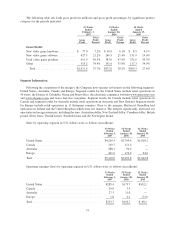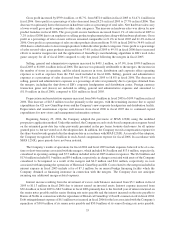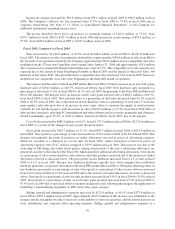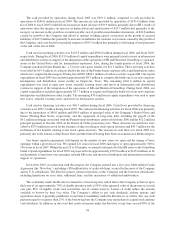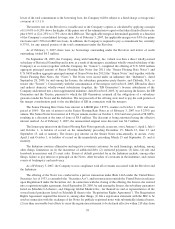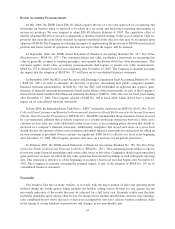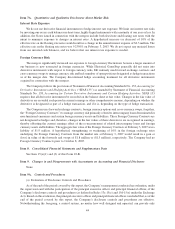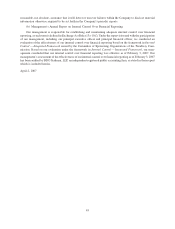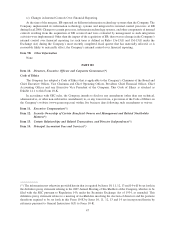GameStop 2006 Annual Report Download - page 53
Download and view the complete annual report
Please find page 53 of the 2006 GameStop annual report below. You can navigate through the pages in the report by either clicking on the pages listed below, or by using the keyword search tool below to find specific information within the annual report.The cash provided by operations during fiscal 2005 was $291.4 million, compared to cash provided by
operations of $146.0 million in fiscal 2004. The increase in cash provided by operations of $145.4 million from
fiscal 2004 to fiscal 2005 resulted from an increase in net income of $39.9 million, primarily due to EB’s results of
operations since the mergers; an increase in depreciation and amortization of $29.7 million due primarily to the
mergers; an increase in the growth in accounts payable, net of growth in merchandise inventories, of $26.8 million
caused by growth of the Company and efforts to manage working capital; an increase in the growth of accrued
liabilities of $29.9 million due primarily to increases in liabilities for customer reservations caused by the growth of
the Company; and a net decrease in prepaid expenses of $19.5 million due primarily to the timing of rent payments
at the end of the fiscal 2004.
Cash used in investing activities was $125.9 million and $996.8 million during fiscal 2006 and fiscal 2005,
respectively. During fiscal 2006, $133.9 million of capital expenditures were primarily used to invest in information
and distribution systems in support of the integration of the operations of EB and Historical GameStop, to open new
stores in the United States and for international expansion. Also, during the fourth quarter of fiscal 2006, the
Company purchased Game Brands Inc., a 72 store video game retailer, for $11.3 million. These investing activities
were offset by $19.3 million of cash provided by the sale of the Pennsylvania corporate office and distribution center
which were acquired in the mergers. During fiscal 2005, $886.1 million of cash was used to acquire EB. Our capital
expenditures in fiscal 2005 also included approximately $9.7 million to complete the build-out of our new corporate
headquarters and distribution center facility in Grapevine, Texas. The remaining $101.0 million in capital
expenditures was used to open new stores, remodel existing stores and invest in information and distribution
systems in support of the integration of the operations of EB and Historical GameStop. During fiscal 2004, our
capital expenditures included approximately $27.7 million to acquire and begin the build-out of our new corporate
headquarters and distribution center facility. The remaining $70.6 million in capital expenditures was used to open
new stores, remodel existing stores and invest in information systems.
Cash used in financing activities was $46.7 million during fiscal 2006. Cash flows provided by financing
activities were $935.7 million during fiscal 2005. The cash used in financing activities for fiscal 2006 was primarily
due to the repurchase of $50.0 million and $50.0 million of principal value of the Company’s Senior Notes and
Senior Floating Rate Notes, respectively, and the repayment of long-term debt, including the payoff of the
$9.2 million mortgage associated with the Pennsylvania distribution center sold in June 2006 and the $12.2 million
principal payment in October 2006 on the Barnes & Noble promissory note. These decreases in cash flows were
offset by $33.9 million received for the issuance of shares relating to stock option exercises and $43.7 million for the
realization of tax benefits relating to the stock option exercises. The increase in cash flows for fiscal 2005 was
primarily due to the issuance of the Senior Notes and the Senior Floating Rate Notes in connection with the mergers.
Our future capital requirements will depend on the number of new stores we open and the timing of those
openings within a given fiscal year. We opened 421 stores in fiscal 2006 and expect to open approximately 500 to
550 stores in fiscal 2007. Within the next 12 to 18 months, we intend to rebrand all of the EB stores to the GameStop
brand. Capital expenditures for fiscal 2007 are projected to be approximately $135.0 million to $145.0 million, to be
used primarily to fund new store openings, rebrand EB stores and invest in distribution and information systems in
support of operations.
In October 2005, in connection with the mergers, the Company entered into a five-year, $400 million Credit
Agreement (the “Revolver”), including a $50 million letter of credit sub-limit, secured by the assets of the Company
and its U.S. subsidiaries. The Revolver places certain restrictions on the Company and the borrower subsidiaries,
including limitations on asset sales, additional liens, and the incurrence of additional indebtedness.
The availability under the Revolver is limited to a borrowing base which allows the Company to borrow up to
the lesser of (x) approximately 70% of eligible inventory and (y) 90% of the appraisal value of the inventory, in each
case plus 85% of eligible credit card receivables, net of certain reserves. Letters of credit reduce the amount
available to borrow by their face value. The Company’s ability to pay cash dividends, redeem options, and
repurchase shares is generally prohibited, except that if availability under the Revolver is or will be after any such
payment equal to or greater than 25% of the borrowing base the Company may repurchase its capital stock and pay
cash dividends. In addition, in the event that credit extensions under the Revolver at any time exceed 80% of the
38





